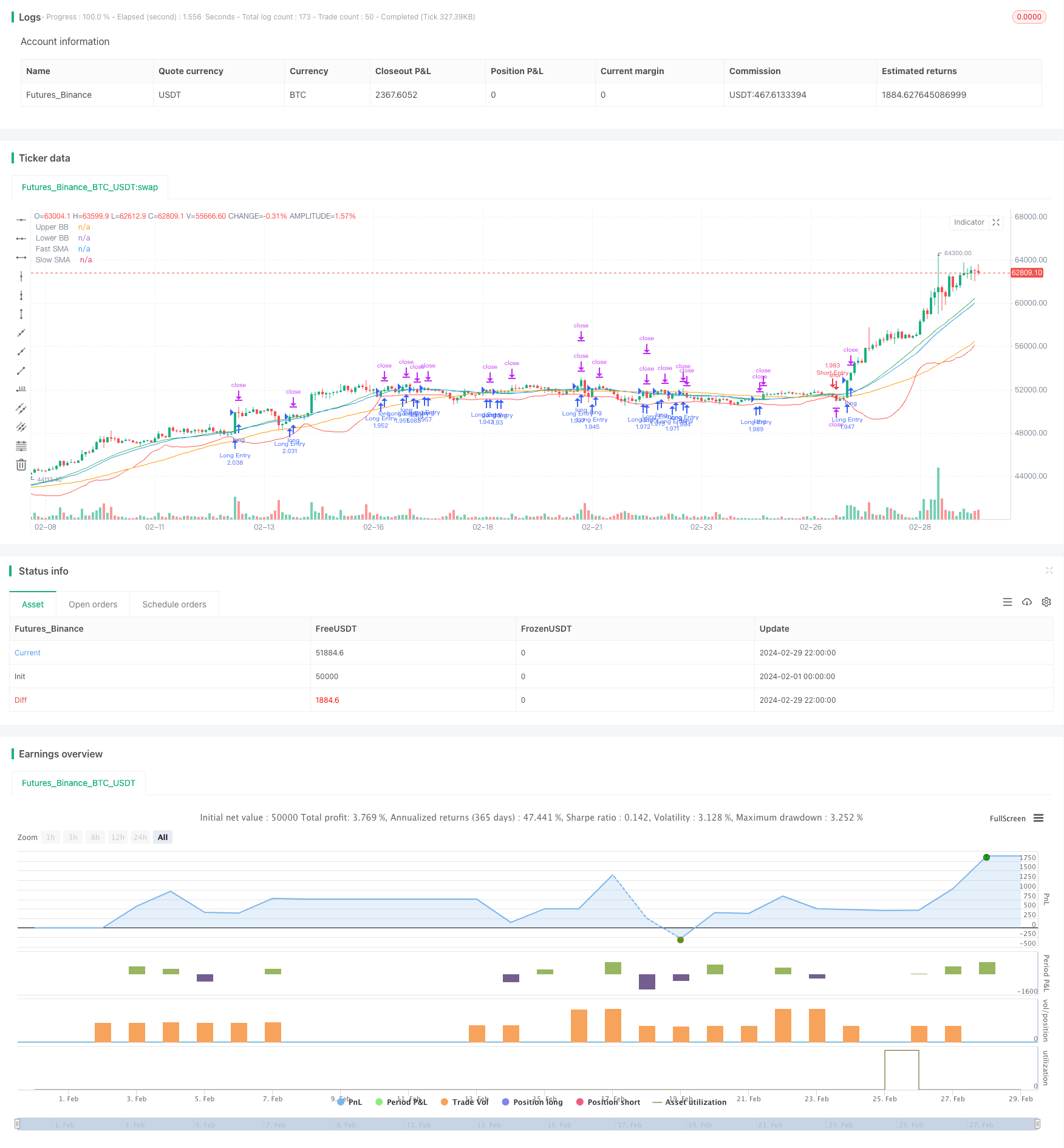
概述
甲易炳量化趋势动量交易策略是一个结合趋势跟踪、动量指标和布林带通道的多头空头量化交易策略。该策略利用快慢移动平均线的交叉来判断趋势方向,同时结合布林带通道和动量指标来确认入场信号。该策略还具有止盈止损、追踪止盈止损以及仓位管理等风险控制措施。
策略原理
该策略的核心原理是利用价格趋势和动量效应来捕捉市场机会。具体来说,该策略使用两条不同周期的移动平均线(快线和慢线)来判断价格趋势的方向。当快线从下向上穿越慢线时,代表上升趋势,策略将产生做多信号;反之,当快线从上向下穿越慢线时,代表下降趋势,策略将产生做空信号。
为了进一步确认趋势和入场时机,该策略还结合了布林带通道和动量指标。布林带由三条线组成:中轨是移动平均线,上轨和下轨分别在中轨的基础上加减一定的标准差。当价格突破布林带上轨时,代表有较强的上涨动能,策略将做多;当价格突破布林带下轨时,代表有较强的下跌动能,策略将做空。
此外,该策略还引入了动量指标,通过比较当前价格与一定周期前的价格来衡量价格的涨跌速度。动量指标可以用来判断趋势的强弱,从而为入场提供额外的确认。
在仓位管理方面,该策略允许根据账户资金和风险偏好来设置头寸规模。同时,策略还设有止盈止损和追踪止盈止损机制,以控制单笔交易的风险敞口。
总的来说,甲易炳量化趋势动量交易策略通过趋势跟踪、动量确认和风险管理等多个维度,力求在捕捉市场趋势机会的同时,严格控制风险,实现稳健的投资回报。
优势分析
趋势跟踪:策略利用快慢均线的交叉来捕捉价格的趋势性机会,既可以做多上涨趋势,也可以做空下跌趋势,适应不同的市场行情。
动量确认:引入动量指标作为趋势的二次确认,有助于排除假信号,提高入场质量。
布林带辅助决策:布林带能够反映价格的波动区间,突破布林带可以视为趋势加速或价格异常波动的信号,为入场提供参考。
仓位管理:策略采用了基于账户资金比例和限额的仓位管理方法,可以灵活控制每笔交易的资金占用,既能充分利用资金,又不会过度暴露于风险。
止盈止损:设置了止盈止损和追踪止盈止损,能够在价格朝预期方向发展时保护利润,同时在价格逆转时果断止损,有效控制单笔交易的最大亏损。
多参数优化:策略包含多个可调整的参数,如均线周期、布林带参数、止盈止损比例等,可以通过参数优化来提高策略的适应性和鲁棒性。
风险分析
频繁交易:该策略根据均线交叉和布林带突破来产生入场信号,当市场波动较大时,可能会频繁产生交易信号,导致交易次数过多,增加手续费成本和滑点成本。
参数敏感:策略包含多个参数,如均线周期、动量周期、布林带参数等,不同参数的选择可能会对策略效果产生较大影响。如果参数选择不当,可能导致策略表现不佳。
趋势识别滞后:移动平均线是一种滞后指标,特别是当均线周期较长时,识别趋势转折的速度会较慢,可能错过最佳的入场时机。
止损风险:虽然策略设置了止损措施,但在极端行情下(如快速跳空),价格可能会直接越过止损价位,导致实际亏损超出预期。
仓位集中风险:如果策略在某个时期连续产生同向信号,可能会导致仓位过度集中于某个方向,面临较大的持仓风险。
流动性风险:策略的回测和实盘效果可能受到市场流动性的影响,特别是在大额资金操作时,可能面临滑点和成交量不足的问题。
优化方向
引入更多技术指标:在当前均线、动量和布林带的基础上,可以尝试引入更多的技术指标,如RSI、MACD等,通过多指标共同确认的方式提高信号的可靠性。
优化入场和出场机制:可以考虑在入场和出场的判断中引入更多条件,如价格突破前必须满足一定的成交量要求,出场时采用分批平仓或移动止盈的方式,以增强策略的灵活性和盈利能力。
动态调整参数:对于均线周期、动量周期、布林带参数等,可以设计一套参数自适应的机制,根据不同市场状态和波动率水平,动态调整参数取值,提高策略的适应性。
改进仓位管理:在当前仓位管理的基础上,可以引入更高级的资金管理方法,如凯利公式、固定比率、动态权益等,以更好地平衡收益与风险。
结合基本面分析:纯技术分析策略可能面临市场无效或失效的风险,如果能够结合一些基本面因素,如宏观经济数据、行业趋势等,对技术信号进行过滤和确认,可能会改善策略效果。
增强回测和实盘的一致性:策略在回测和实盘中的表现可能存在差异,需要重点关注回测和实盘的执行质量,包括成交价格、滑点、延迟等因素,以确保实盘表现与回测结果的一致性。
总结
甲易炳量化趋势动量交易策略是一个融合了多种技术分析方法的量化交易策略。它利用均线交叉捕捉趋势,布林带突破确认走势,动量指标反映速度,止盈止损控制风险,仓位管理优化资金利用,形成了一套完整的交易决策和管理体系。
该策略的优点在于趋势跟踪与动量结合,布林带辅助判断,仓位管理和止盈止损兼顾,通过多维度的分析和决策来把握市场机会。但同时,该策略也面临频繁交易、参数敏感、趋势识别滞后、止损无法覆盖极端行情等潜在风险。这就需要通过引入更多技术指标、优化信号判断逻辑、动态调整参数、改进资金管理等措施来不断改进和完善策略。
此外,量化交易策略在回测结果与实盘表现之间可能存在差异,这就需要重点关注成交价格、滑点、延迟等执行层面的问题,以提高策略的可实践性和稳定性。同时,量化策略也不应局限于技术分析,适当结合基本面因素,将有助于提高决策的全面性和有效性。
总的来说,甲易炳量化趋势动量交易策略为量化交易实践提供了一个较为完整和可行的思路,但策略的最终效果还取决于对各种机会和风险的权衡以及细节的优化。在实际应用中,需要根据自己的风险偏好、资金规模、交易市场等具体情况,对策略进行适当的调整和改进,并在实盘运行中持续监控和优化,以追求更加稳健和理想的策略表现。
/*backtest
start: 2024-02-01 00:00:00
end: 2024-02-29 23:59:59
period: 2h
basePeriod: 15m
exchanges: [{"eid":"Futures_Binance","currency":"BTC_USDT"}]
*/
//@version=5
strategy('甲易炳', overlay=true)
// Parameters
trendPeriod = input(50, 'Trend Period')
momentumPeriod = input(14, 'Momentum Period')
bbPeriod = input(20, 'Bollinger Bands Period')
bbDeviation = input(2, 'Bollinger Bands Deviation')
fastMALen = input(23, 'Fast SMA Length')
slowMALen = input(50, 'Slow SMA Length')
longTakeProfitPerc = input.float(0.5, 'Long Take Profit %', minval=0.05, step=0.05) * 0.01
shortTakeProfitPerc = input.float(0.5, 'Short Take Profit %', minval=0.05, step=0.05) * 0.01
stopLossPerc = input.float(0.5, 'Stop Loss %', minval=0.05, step=0.05) * 0.01
enableTrailing = input.bool(true, 'Enable Trailing')
trailingTakeProfitPerc = input.float(0.01, 'Trailing Take Profit %', minval=0.01, maxval=100, step=0.01) * 0.01
trailingStopLossPerc = input.float(0.5, 'Trailing Stop Loss %', minval=0.05, step=0.05) * 0.01
qty_percent = input.int(20, 'Position Size %', step=1)
qty_cap = input.int(10000, 'Max Position Size', step=1000)
beast_mode = input.bool(false, 'Beast Mode')
set_cap = input.bool(true, 'Cap Position Size')
strategy.initial_capital = 50000
// Calculate position size
qty1 = (strategy.initial_capital + strategy.netprofit) * qty_percent / 10 / close
qty = (set_cap and qty1 > qty_cap) ? qty_cap : qty1
// Calculate moving averages
fastMA = ta.sma(close, fastMALen)
slowMA = ta.sma(close, slowMALen)
// Bollinger Bands
[upperBB, middleBB, lowerBB] = ta.bb(close, bbPeriod, bbDeviation)
// Entry conditions
buySignal = ta.crossover(close, fastMA) and close > upperBB
sellSignal = ta.crossunder(close, fastMA) and close < lowerBB
// Rampage mode entry conditions
if beast_mode
buySignal := buySignal and fastMA > fastMA[2]
sellSignal := sellSignal and fastMA < fastMA[2]
// Active positions
longIsActive = buySignal or strategy.position_size > 0
shortIsActive = sellSignal or strategy.position_size < 0
// Declare take profit and stop loss variables
var float longTakeProfitPrice = na
var float shortTakeProfitPrice = na
// Take profit and stop loss calculation
if longIsActive
if buySignal and not (strategy.position_size > 0)
longTakeProfitPrice := close * (1 + longTakeProfitPerc)
else
longTakeProfitPrice := nz(longTakeProfitPrice[1], close * (1 + longTakeProfitPerc))
if shortIsActive
if sellSignal and not (strategy.position_size < 0)
shortTakeProfitPrice := close * (1 - shortTakeProfitPerc)
else
shortTakeProfitPrice := nz(shortTakeProfitPrice[1], close * (1 - shortTakeProfitPerc))
longTrailingTakeProfitStepTicks = longTakeProfitPrice * trailingTakeProfitPerc / syminfo.mintick
shortTrailingTakeProfitStepTicks = shortTakeProfitPrice * trailingTakeProfitPerc / syminfo.mintick
longTrailingStopLossPrice = close * (1 - trailingStopLossPerc)
shortTrailingStopLossPrice = close * (1 + trailingStopLossPerc)
// Entries and exits
if strategy.position_size == 0
strategy.entry('Long Entry', qty=qty, direction=strategy.long, when=buySignal, alert_message='Long Entry')
strategy.entry('Short Entry', qty=qty, direction=strategy.short, when=sellSignal, alert_message='Short Entry')
strategy.exit('Long Take Profit', 'Long Entry', loss=close * stopLossPerc / syminfo.mintick, limit=enableTrailing ? na : longTakeProfitPrice, trail_price=enableTrailing ? longTakeProfitPrice : na, trail_offset=enableTrailing ? longTrailingTakeProfitStepTicks : na, when=longIsActive, alert_message='Long Take Profit')
strategy.exit('Short Take Profit', 'Short Entry', loss=close * stopLossPerc / syminfo.mintick, limit=enableTrailing ? na : shortTakeProfitPrice, trail_price=enableTrailing ? shortTakeProfitPrice : na, trail_offset=enableTrailing ? shortTrailingTakeProfitStepTicks : na, when=shortIsActive, alert_message='Short Take Profit')
else
if longIsActive
strategy.exit('Long Stop Loss', 'Long Entry', stop=longTrailingStopLossPrice, when=longIsActive)
if shortIsActive
strategy.exit('Short Stop Loss', 'Short Entry', stop=shortTrailingStopLossPrice, when=shortIsActive)
// Plotting
plot(fastMA, 'Fast SMA', color=color.blue, linewidth=1, style=plot.style_line)
plot(slowMA, 'Slow SMA', color=color.orange, linewidth=1, style=plot.style_line)
plot(upperBB, 'Upper BB', color=color.green, linewidth=1, style=plot.style_line)
plot(lowerBB, 'Lower BB', color=color.red, linewidth=1, style=plot.style_line)